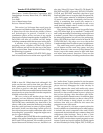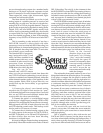
are two-channel analog outputs for a standard audio
hookup to a CD player input and a separate six-jack
bank of connectors for multi-channel audio outputs.
These output left, center, right, left-surround, right-
surround, and subwoofer signals.
The latter should be hooked up to the six-jack
analog inputs of a suitable processor or receiver and
normally they would carry the player’s decoded-to-
analog SACD or DVD-A program material. These six
jacks can also output player-decoded-to-analog Dolby
Digital, DTS, and even MPEG signals, mostly from
movies. And very interesting indeed, they also are able
to output Dolby Pro Logic II decoded signals derived
from two-channel programs, at least if the sampling
frequency of any SACD or PCM sources is below 88.2
kHz.
This is something to take seriously if one has a
DVD-S1500, because it allows those with older
processors or receivers that lack DPL II decoding, but
which still have six-channel analog inputs, to now have
DPL II playback decoding from their CD and other
two-channel source materials.
The Yamaha DSP-A1 processor/
amp I reviewed in issue 72, and
which I still have installed in my
middle system is this way, as are
a number of other receivers and
processors I have reviewed. I
consider this feature the DVD-
S1500 offers to be a fairly big deal.
Yep, why opt for two-
channels only with CD sources
when you can get surround sound from them this
easy? DPL II surround synthesizing is nearly always
superior to standard two-channel playback, unless the
center-channel speaker quality or the position of that
center speaker stinks. With a player like this, one
would hook up the device thusly to get optimum
flexibility:
1) Connect the player’s two-channel analog
outputs to the CD input of their receiver for “pure”
two-channel playback from compact discs. One could
also use any DSP surround-synthesis modes their
receiver offers for a faux surround effect.
2) Connect the optical- or coaxial-digital output
to the receiver’s digital input, primarily for DD or DTS
playback. This would mostly be used for movie sound,
although nearly all DVD-A music discs also have DD
and DTS alternate sound tracks. This hookup could
also be used for CD sources, of course.
3) Connect the six-channel analog outputs to the
5.1 analog inputs of the receiver for SACD, DVD-A,
and DPL II playback, or for DD and DTS playback if
an older receiver does not have those decoding
functions via a digital input.
It is hard to imagine a better hookup arrangement,
particularly if that older-model receiver lacks on-board
DPL II decoding. The only fly in the ointment is that
the DVD-S1500’s on-board DPL II processing is factory
set and does not offer the fine tuning the technology
included in some upscale receivers. Still, it works well
and was superior to standard two-channel playback
with all of the source material I tried.
The DVD-S1500’s remote is pretty basic. It includes
some cool special-function buttons: audio direct, page
turning for DVD-A still pictures, subtitle, angle, zoom,
on-screen and front-panel status, shuffle, and an auto-
scan feature to check out the first ten seconds of each
track. And of course it offers the usual group of
standard controls that must be included for decent
control of the player: play, pause, skip, menu, etc.
However, there is one exception: there are no slow
or fast “scan” buttons on the remote. Instead, if one
wants to scan forward or backward they have to hold
down the “skip” button for two seconds and then the
skip feature is bypassed and scanning takes place. (The
manual mentions this fast-scan feature on the remote
control’s description page, but indicated that it only
works in the forward
direction. Nope, it can work
backwards, too.) Hitting
“play” stops the scanning
and returns the speed to
normal. Unfortunately, there
is no way to easily control the
scanning speed. To do this
one has to access the on-
screen menu and awkwardly
make the changes.
The minimalist front-panel readout is one of two
things that bothered me about the player. For example,
if one plays a compact disc the player’s readout will
briefly indicate which track is playing right after it is
selected and then delete that information and present
a continuous time-play readout. To check the track
being played one has to press the “status” button on
the remote. If one wants a continuous view of what is
going on with any kind of source material (track that
is playing, track-time readout, and total time of the
disc) they have to turn on the TV set and read the
information on the screen. The menu was at first
awkward to navigate (the way the icons shift around
is odd), no matter what kind of source material was
involved, although after a while I got the hang of it.
Still, it was anything but intuitive.
The second sore spot with me involved the
player’s cue-up time. No matter the source material,
it took the device quite some time to access the data
and begin playing.
One is normally used to this with movies and
SACD and DVD-A sources, but the player was also
very slow when initially dealing with compact discs. I
mean, when typically accessing a CD after closing the
tray the unit whirred and clicked and went on and on










